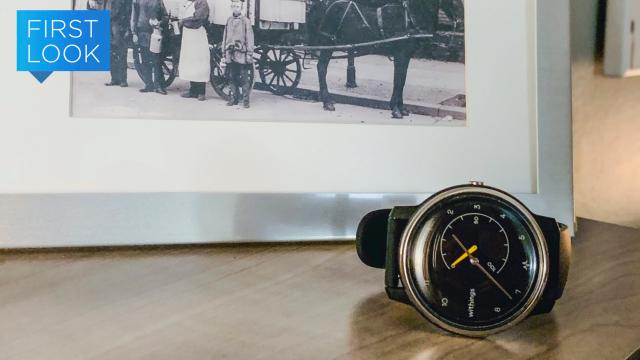Withing’s long-promised budger rival to the Apple Watch is shipping. Back at CES, Withings gave us a peek at the Move ECG, a $US130 ($191) activity tracker that offered the same electrocardiogram capabilities as the Apple Watch Series 4. Nine months later at IFA, it’s finally available—but only if you live in Europe.
Now before you start getting angry, it’s not Withings’ fault for the delay. Back in January, Withings told me the watch was undergoing the long and arduous clearance process with the U.S. Food and Drug Administration (FDA) and expected and the Move ECG is still waiting for FDA clearance. The only reason it’s currently available in Europe is the Conformité Européenne (CE) just recently stamped its mark of approval on the product.
Funny enough, nothing’s really changed from the device I peeped at all those months ago. The design is the same, the features are the same (basic activity and sleep tracking, no notifications), and taking an ECG is exactly as it was demonstrated to me in Las Vegas. I’m sure there were some behind-the-scenes software tweaks, but the product itself isn’t drastically different. It truly has just been waiting for the FDA to grant de novo clearance so that you, the consumer, can trust Withings did its due diligence in developing the ECG feature.
You might think the Apple Watch Series 4 pioneered ECGs on the wrist. It didn’t—it was just the first to get regulatory clearance, and in a remarkably short time at that. (That’s your cue, Apple conspiracy theorists.) But other wearables hoping to get the FDA’s blessings have taken much, much longer. The Omron HeartGuide, a blood pressure smartwatch, took two years of clinical testing. Withings’ other ECG product, the BPM Core, is also still awaiting approval. Asus just announced an ECG-capable smartwatch at IFA with an expected shipping date of Q4 2019—though if the Move ECG is any indicator of timing, I have serious doubts it’ll get FDA clearance by then.
Ostensibly, we’d have way more ECG gizmos and doodads if regulatory bodies like the FDA or CE didn’t exist. But in this case, regulation hell, while frustrating, serves a purpose. Technology likes to move at the speed of light, but medicine infamously does not. Wearables like these walk a thin line between innocuous pseudoscience (10,000 steps a day!) and potentially dangerous marketing claims of being “medical grade” devices. If erring on the side of consumer safety means lengthy waits, then so be it.
The flip side is lengthy vetting processes limit medical wearable innovations to companies with deep pockets. Omron is a well-established medical equipment maker. Apple has a gajillion dollars stashed in its coffers. Meanwhile, Withings is known by the tech savvy, but it’s not a household name in the vein of Samsung, Apple, Google, or Fitbit. That’s a shame because the Move ECG is an accessible device that offers novel tech at a reasonable price.
So how does the Move ECG compare to the Series 4? It’s shockingly similar, which makes one wonder why it’s taking this long. With the Apple Watch, you open the ECG app on the watch, read a bunch of warnings, and sit calmly for 30 seconds with your finger on the digital crown. With the Move ECG, you read another bunch of warnings, push a button, relax, and lightly rest your fingers on each side of the metal case. On both watches you’re essentially creating a closed circuit with your body and the watch acts as an electrode.
I took test readings with both the Series 4 and the Move ECG and to my relief, both watches say I have a normal sinus rhythm heartbeat and a resting heart rate of about 64 bpm. Both offer me in-app options to share my results with doctors.
The main difference is the Move ECG opts for a coin cell battery and eschews fancy features and notifications. It’s not the most advanced wearable out there, but its sleek design and minimalist approach has a lot of appeal. (Moreso than its even simpler cousin, the Withings Move.)
